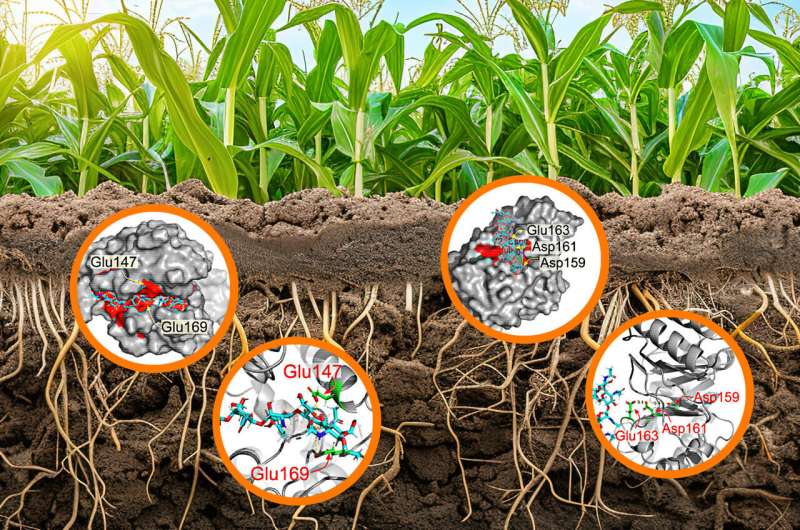This article has been reviewed according to Science X's editorial process and policies. Editors have highlighted the following attributes while ensuring the content's credibility:
fact-checked
peer-reviewed publication
trusted source
proofread
New understanding of a common plant enzyme could lead to better crop management

New findings about chitinases, enzymes found naturally in plants, could allow farmers to address fungal infections sooner and more efficiently.
Researchers from the U.S. Department of Energy Ames National Laboratory investigated chitinases from corn and rice to better understand their roles in indicating if a plant is under stress and combating fungal attacks. Their findings suggest that these enzymes could be a valuable resource not only for monitoring crop health overall, but also for optimizing biomass for use in alternative energy sources.
Two of the most important agricultural crops worldwide are corn and rice. In addition to providing food, both have important energy applications as well through the use of their waste plant matter, or biomass, from crop harvesting. Corn is a major crop used to create biofuel, while rice husks are used for heating, electricity, and biofuel.
One major threat to crop yields comes from pathogens such as fungi, bacteria, and viruses. Fungi alone cause a 35%–40% yield loss in corn and rice crops each year.
"There's a lot of interest in chitinases in the plant world because of their general occurrence and their involvement in protecting plants from fungal attacks" explained Marit Nilsen-Hamilton, a scientist at Ames Lab and leader of the research team. "Chitinases are really important to plants for protection."
Much of Nilsen-Hamilton's work is focused primarily on the rhizosphere, a narrow zone of soil around plant roots where intense microbial activity takes place. Roots in the soil release many substances, including sugars and chitinases, as well as polymers that hold everything together. Bacteria in the soil also contribute to these excretions, and the polymers they release form a very thin film over the plant roots.
"In the rhizosphere, the plants secrete sugar to attract the bacteria, because they want those rhizobacteria to be around and to help them out. Plants feed the bacteria and the bacteria feed and protect the plants," Nilsen-Hamilton said. "Still, there are these fungal infections and when the plants are under stress it will cause them to release chitinases."
Her team chose specific chitinases recommended by their collaborating plant biochemist, Olga Zabotina, that are released by the plants in response to fungal attack. Their first step was gaining a full understanding of the enzymes' functional and molecular characteristics.
"Very little has been done with chitinases in general in terms of the purification and characterization," Nilsen-Hamilton explained. "So, my graduate student Samuel Shobade undertook the job of characterizing them."
The team wanted to know whether these chitinases are a good indicator of fungi-related plant stress, and whether they could kill fungi. They found that one of the chitinases was effective at killing the Aspergillus niger fungi, which can cause black mold in a variety of agricultural crops.
In addition to characterizing the chitinases, the team also wanted to know if any would be good receptors for aptamers. "Aptamers are nucleic acids that behave like antibodies, but you don't need an animal to make them. In fact, you make them in a test tube," Nilsen-Hamilton explained.
Aptamers can be used to detect chitinases and could potentially be used to activate certain chitinases that are secreted in response to fungal infections. The chitinase from the rice proved to be a bad target for aptamers, because both the enzyme and the aptamer protein are negatively charged, so they repelled each other. However, the corn chitinase turned out to be a good aptamer receptor.
This research also helps Nilsen-Hamilton's work on using nucleic acid aptamers to detect fungal disease early before it is too late for the plant's survival.
"Our engineering collaborator, Pranav Shrotriya, has developed a way of using nucleic acid aptamers to detect molecules by using what's called an electrochemical device. And the probe can be made so small that it can be put down into the soil. So that gives us the opportunity to detect things in the soil that plant roots make, that bacteria make, etc.," she said.
Characterizing these chitinases has been an important contribution to her team's work towards being able to detect these proteins released by the plants. The ability to detect them early can allow farmers to intervene early, when the infection can be more easily resolved.
Understanding the chitinases can also lead to more targeted treatments than applying a general fungicide or intervening when plants finally look stressed. The findings could have economic impact not only on traditional agricultural crops and their waste biomass for energy production, but also on dedicated energy crops—those grown specifically to create biomass for fuel.
This research is further discussed in "Plant root associated chitinases: structures and functions," written by Samuel O. Shobade, Olga A. Zabotina, and Marit Nilsen-Hamilton, and published in Frontiers in Plant Science.
More information: Samuel O. Shobade et al, Plant root associated chitinases: structures and functions, Frontiers in Plant Science (2024). DOI: 10.3389/fpls.2024.1344142
Journal information: Frontiers in Plant Science
Provided by Ames National Laboratory




















